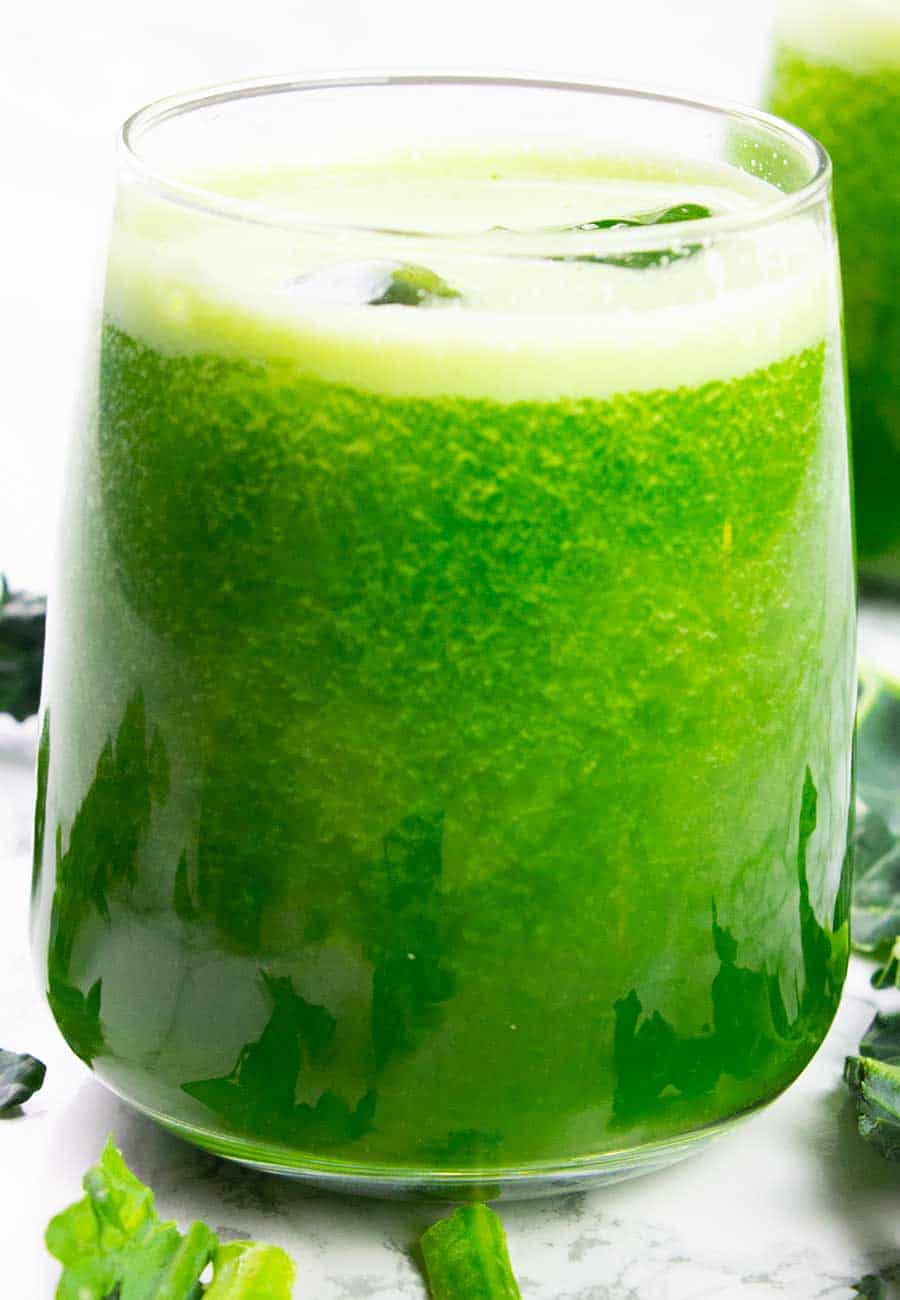This green kale juice recipe is detoxifying and incredibly good for your health. Let us explain why.
Kale, celery, cucumber, pears, ginger are all brilliantly healthy for us. Celery and cucumber are hydrating, ginger is anti-inflammatory, kale is cancer-fighting and pear is packed with crucial antioxidants. Let’s talk a bit more about kale juice benefits.
Kale juice benefits
Kale, perhaps one of the healthiest greens out there, has lots of benefits, especially when juiced. Juicing kale gives you a healthy drink packed with lots of vitamins and minerals. Kale does equally well when cooked, but it’s when juiced or blended with other healthy ingredients that it adds so much value to juices and smoothies.
If you have ever wondered how to eat kale and why you should eat it then hopefully the cancer-fighting properties of this cruciferous vegetable should be a good reason. Kale belongs to the cruciferous vegetable family together with brussels sprouts, broccoli, collard greens and cabbage. Kale leaves can be either purple or green with either curly or smooth shape which can all be juiced or blended.
When juicing kale you end up with boosting your body with vitamin A, B6, C and K, including calcium, manganese, magnesium, potassium and copper as well as niacin (vitamin B3), riboflavin (vitamin B2) and thiamin (vitaminB1), phosphorus and iron.
Kale is a highly low-calorie vegetable with some fat most of which is alpha linolenic-acid (a healthy omega-3 fatty acid).
Being low in calories and intense in nutrients, kale is arguably one of our top nutrient-dense vegetables. The green leafy vegetable also includes lots of important antioxidants, particularly vitamin C and beta-carotene, polyphenols and flavonoids. These antioxidants are critical in counteracting the damaging oxidation of our body’s free radicals, which can cause cancer, aging and other health problems.
Other antioxidants in your typical serving of kale juice include kaempferol and quercetin flavonoids, which have been widely studied and found to be highly protective of the heart, lower blood pressure, highly anti-cancer, antidepressant, anti-viral and anti-inflammatory.

Kale juice and cholesterol
Kale is also very good in order to keep your bad cholesterol levels down. The actual cholesterol is very important in the body where it is transformed into fat-digesting bile acids in the liver and is released every time fatty foods are consumed. After absorbing the fats, bile acids are reabsorbed within the bloodstream for future use. However, the reabsorption of bile acids can be curtailed and hindered by bile acid sequestrants, in the process lowering the total cholesterol in our bodies. Kale juice is packed with bile acid sequestrants which means that it can lower our cholesterol levels and help minimise heart disease risk.
In fact, research has shown that the intake of kale juices consistently for 3 months every single day boosted not only antioxidant levels in the body but also good cholesterol (HDL) by 27 percent while lowering bad cholesterol (LDL) by 10 percent. Interestingly, other studies have shown that steamed kale has been very effective in lowering cholesterol just like the cholesterol-lowering medication you get from the doctors.
Kale juice as a cancer fighter
Cancer is uncontrollable cell growth in the body. Kale juice is packed with cancer-protective nutrients. These include sulforaphane, an effective molecular-level cancer-fighting element and indole-3-carbinol. While studies in the effectiveness of cruciferous vegetables in cancer prevention are ongoing, the clinical results in human beings are promising.
Typical glass of healthy kale green juice includes lots of minerals most people aren’t sufficiently getting today. Kale juice includes calcium that helps in cellular functioning and improving bone health. Magnesium in kale is notable for its potential protection from heart diseases and diabetes type 2. Potassium is another mineral in kale, effective in maintaining cellular electrical gradients inside the body, which is good for lowering heart disease and blood pressure risks.
Kale vs Spinach
Both spinach and kale are highly nutritious. However, both are not the same in terms of the density of nutrients. Spinach contains about half of the calories in a typical kale serving and lots of fibre. Folic acid is also high in spinach, superb for pregnant women and more magnesium and iron than kale. However, kale packs more nutrients in the right elements such as more calcium and protein than spinach. Kale juice delivers over four times vitamin C in the same spinach juice serving, including more vitamin K and vitamin A than spinach. Vitamin A is perfect for skin and eye health while vitamin K is critical for healthy blood clotting and bone protection.
Have you made this kale juice recipe?
We’d love to see your green juice creations! Please leave a comment below, share or tag using @anticancerkitchen on Instagram and hashtag it #anticancerkitchen.
For more anti-cancer juice and smoothies recipes, click here.

Ingredients
- 3 celery stalks
- 1 large cucumber
- 2 pears
- 2 cups of kale
- 5 cm ginger
Instructions
All you need is a juicer and juice celery, cucumber, pears, kale and ginger.
 Copyright secured by Digiprove © 2020 The Anti-Cancer Kitchen
Copyright secured by Digiprove © 2020 The Anti-Cancer Kitchen

